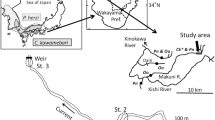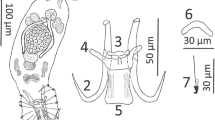Abstract
The only known non-avian vertebrate obligate brood parasite is the cuckoo catfish (Synodontis multipunctatus), a Lake Tanganyikan endemic. The cuckoo catfish parasitizes Tanganyikan mouthbrooding cichlids, and under captive conditions, will also parasitize cichlids from other Rift Valley lakes. Here we examine the frequency of parasitism by the cuckoo catfish of Ctenochromis horei from Lake Tanganyika and three species from Lake Malawi and the greater Lake Victorian system in a laboratory setting. C. horei was parasitized significantly less (17%) than the allopatric species Haplochromis latifasciatus, Haplochromis nubilus, and Metriaclima estherae (combined parasitism rate of 28%). The lower rates of parasitism in C. horei may be due to differences in the mating ritual, oviposition (e.g., long periods of pseudo-spawning before actual oviposition), and behavioral adaptations (e.g., increased aggression towards the cuckoo catfish). The number of catfish eggs per parasitized brood was similar between C. horei, H. latifasciatus, H. nubilus, and M. estherae. Our results are comparable to findings from the field for C. horei parasitism frequency and number of cuckoo catfish per brood. We also analyzed the parasitism rate of the albino morph of Metriaclima zebra, a domestic strain. Parasitism rates and number of catfish per brood were the highest in the albino morphotype suggesting that the higher levels of parasitism may be related to lower aggressive behavior, lower visual acuity, or captive influence. Cuckoo catfish and mouthbrooding cichlids provide a model system for testing brood parasitism in a laboratory setting.




Similar content being viewed by others
References
Abadi RV, Pascal E (1991) Visual resolution limits in human albinism. Vis Res 31(7):1445–1447
Barlow GW (2000) The cichlid fishes: Nature's grand experiment in evolution. Perseus Publishing, Cambridge, MA
Boulenger GA (1898) Report on the fishes recently obtained by Mr. J.E.S. Moore in Lake Tanganyika. Proc Zool Soc London 1898(pt 3):494–497
Boulenger GA (1899) A revision of the African and Syrian fishes of the family Cichlida.–part II.1. Proc Zool Soc London 67(1):98–144. https://doi.org/10.1111/j.1469-7998.1899.tb06852.x
Boulenger GA (1906) Descriptions of new fishes discovered by Mr. E. Degen in Lake Victoria. Annals and Magazine of Natural History. Vol (series 7) vol. 17 (no. 101) p(Art 49): 433–452
Brichard P (1979) Unusual breeding behavior in Lake Tanganyika cichlids Buntbarshe. Bulletin 74:10–12
Cervo R, Macinai V, Dechigi F, Turillazzi S (2004) Fast growth of immature brood in a social parasite wasp: a convergent evolution between avian and insect cuckoos. Am Nat 164(6):814–820
Cruz A, Knox J, Pawlowski S (2004) Caregiving-brood parasitism in freshwater fish. In: Bekoff M (ed) Encyclopedia of animal behavior. Vol 1. Greenwood Press, pp 180–182
Danley PD, Kocher TD (2001) Speciation in rapidly diverging systems: lessons from Lake Malawi. Mol Ecol 10:1075–1086
Davies N (2000) Cuckoos, cowbirds and other cheats. T & a. D. Poyser Ltd, London
Davies NB, Brooke ML (1989) An experimental study of co-evolution between the cuckoo, Cuculus canorus, and its hosts. I. Host egg discrimination. J Anim Ecol 58(1):207–224. https://doi.org/10.2307/4995
Davies NB, Bourke AFG, Brooke ML (1989) Cuckoos and parasitic ants: interspecific brood parasitism as an evolutionary arms race. Trends Ecol Evol 4(9):274–278. https://doi.org/10.1016/0169-5347(89)90202-4
Dawkins R, Krebs JR (1979) Arms races between and within species. Proc R Soc B Biol Sci 205(1161):489–511. https://doi.org/10.1098/rspb.1979.0081
Duckworth J (1991) Responses of breeding reed warblers Acrocephalus scirpaceus to mounts of sparrowhawk Accipiter nisus, cuckoo Cuculus canorus and jay Garrulus glandarius. Ibis 133(1):68–74
Ducrest AL, Keller L, Roulin A (2008) Pleiotropy in the melanocortin system, coloration and behavioural syndromes. Trends Ecol Evol 23(9):502–510. https://doi.org/10.1016/j.tree.2008.06.001
Eccles DH (1992) FAO species identification sheets for fishery purposes. Field guide to the freshwater fishes of Tanzania. Food and Agriculture Organization of the United Nations, Rome:145 p
Feeney WE, Welbergen JA, Langmore NE (2014) Advances in the study of coevolution between avian brood parasites and their hosts. In: Futuyma DJ (ed) Annu Rev Ecol Evol Syst, Vol 45. Annual Review of Ecology Evolution and Systematics, vol 45. Annual Reviews, Palo Alto, p 227–246
Ferguson J (1983) Observations of a spawning of Synodontis multipunctatus among rift Lake cichlids Buntbarshe. Bulletin 98:13–16
Finley L (1983) Synodontis multipunctatus, reproduction and maternal Mouthbrooding cichlids - a cuckoo relationship? Buntbarshe Bulletin 98:13–16
Finley L (1984) Reproduction in Synodontis multipunctatus Freshw Mar Aquar vol 7, p 22–25, 63, 66–75,
Fossøy F et al (2011) Genetic differentiation among sympatric cuckoo host races: males matter. Proc R Soc B Biol Sci 278(1712):1639–1645
Friedmann H (1929) The cowbirds: a study in the biology of social parasitism (Charles C. Thomas, Springfield, Ill.). 1963. Host relations of the parasitic cowbirds. US Nat Mus Bull(223)
Friel JP, Vigliotta TR (2006) Synodontis acanthoperca, a new species from the Ogooue River system, Gabon with comments on spiny ornamentation and sexual dimorphism in mochokid catfishes (Siluriformes : Mochokidae). Zootaxa(1125):45–56
Fryer G, Iles TD (1972) The cichlid fishes of the Great Lakes of Africa: their biology and evolution. Oliver and Boyd, Edinburgh
Günther A (1894) Descriptions of the reptiles and fishes collected by Mr. E Coode-Hore on Lake Tanganyika. Proc Zool Soc London 1893(pt4):628–632
Hothorn T, Bretz F, Westfall P (2008) Simultaneous inference in general parametric models. Biom J 50(3):346–363
Kaufman L (1996) Haplochromis latifasciatus. The IUCN Red List of Threatened Species 1996: e.T2195A9341435 In. http://www.iucnredlist.org/details/2195/0 Accessed October 2017
Keenleyside MHA (1991) Parental Care. In: Keenleyside MHA (ed) Cichlid fishes: behavior, ecology, and evolution. Chapman and Hall, London, pp 191–208
Kilner RM, Langmore NE (2011) Cuckoos versus hosts in insects and birds: adaptations, counter-adaptations and outcomes. Biol Rev 86(4):836–852
Koblmuller S, Sturmbauer C, Verheyen E, Meyer A, Salzburger W (2006) Mitochondrial phylogeny and phylogeography of east African squeaker catfishes (Siluriformes: Synodontis). BMC Evol Biol 6(1):49
Kocher TD (2004) Adaptive evolution and explosive speciation: the cichlid fish model. Nat Rev Genet 5:288–298
Konings A (1995) Description of Pseudotropheus estherae sp. nov., the well-known red zebra cichlid from Lake Malawi. Tropical fish hobbyist (may 1995). p 206–210,
Lande R, Seehausen O, van Alphen JJM (2001) Mechanisms of rapid sympatric speciation by sex reversal and sexual selection in cichlid fish. Genetica 112-113(1):435–443
Lashley KS (1930) The mechanism of vision: III. The comparative visual acuity of pigmented and albino rats. Pedagogical Seminary and Journal of Genetic Psychology 37(4):481–484
Loiselle PV (1998) Egg holders: how Synodontis catfish can use cichlids from two continents to hatch their young. Aquarium Fish Magazine 10:5–6
Molina-Morales M, Martinez JG, Martin-Galvez D, Dawson DA, Burke T, Aviles JM (2014) Cuckoo hosts shift from accepting to rejecting parasitic eggs across their lifetime. Evolution 68(10):3020–3029. https://doi.org/10.1111/evo.12471
Ochi H (1993) Mate monopolization by a dominant male in a multi-male social group of a mouthbrooding cichlid, Ctenochromis horei. Japanese Journal of Ichthyology 40(2):209–218
Ortega CP (1998) Cowbirds and other brood parasites. University of Arizona Press
Payne RB (1977) The ecology of brood parasitism in birds. Annual Review of Ecology and Systematics 8:1–28
Peer BD, Rothstein SI (2010) Phenotypic Plasticity in Common Grackles (Quiscalus quiscula) in Response to Repeated Brood Parasitism. The Auk 127(2):293–299. https://doi.org/10.1525/auk.2009.09063
Poll M (1971) Revision des Synodontis africains (famille Mochocidae). Musée royal de l’Afrique centrale.
Questar-Inc. (2000) “National Geographic’s Lake Tanganyika - Jewel of the Rift” (VHS), Alexander Grasshoff and Al Giddings (Producers).
R Core Team (2018) R: A Language and Environment for Statistical Computing. R Foundation for Statistical Computing, Vienna, Austria, https://www.R-project.org
Regan CT (1929) New cichlid fishes from lakes Victoria, Kioga, and Albert. Annals and Magazine of Natural History. vol (Series 10) vol. 3 (no.16), p 388–392,
Ren JQ, McCarthy WR, Zhang H, Adolph AR, Li L (2002) Behavioral visual responses of wild-type and hypopigmented zebrafish. Vis Res 42(3):293–299
Ribbink A (1990) Alternative life-history styles of some African cichlid fishes. Environ Biol Fishes 28(1–4):87–100. https://doi.org/10.1007/BF00751029
Robertson RJ, Norman RF (1976) Behavioral Defenses to Brood Parasitism by Potential Hosts of the Brown-Headed Cowbird. The Condor 78(2):166–173. https://doi.org/10.2307/1366851
Robertson RJ, Norman RF (1977) The function and evolution of aggressive host behavior towards the brown-headed cowbird (Molothrus ater). Can J Zool 55(3):508–518. https://doi.org/10.1139/z77-066
Rothstein SI (1975) An experimental and teleonomic investigation of avian brood parasitism. The Condor 77(3):250–271
Rothstein SI (1990) A Model System for Coevolution: Avian Brood Parasitism. Annual Review of Ecology and Systematics 21(ArticleType: research-article / Full publication date: 1990 / Copyright ¬© 1990 Annual Reviews):481–508.
Sato T (1986) A brood parasitic catfish of mouthbrooding cichlid fishes in Lake Tanganyika. Nature 323:58–59
Slavík O, Horký P, Wackermannová M (2016) How does agonistic behaviour differ in albino and pigmented fish? PeerJ 4:e1937.
Snoeks J (2000) How well known is the ichthodiversity of the large East African lakes? In: Rossiter A, Kawanabe H (eds) Advances in Ecological Research - Ancient Lakes: Biodiversity, Ecology, and Evolution. vol 31. Academic Press, p 17–38.
Sturmbauer C et al (2008) Abundance, distribution, and territory areas of rock-dwelling Lake Tanganyika cichlid fish species. Hydrobiologia 615(1):57–68. https://doi.org/10.1007/s10750-008-9557-z
Sturmbauer C, Husemann M, Danley P (2011) Explosive Speciation and Adaptive Radiation of East African Cichlid Fishes. In: Zachos FE, Habel JC (eds) Biodiversity Hotspots. Springer, Berlin Heidelberg, pp 333–362
Thorogood R, Davies NB (2013) Reed warbler hosts fine-tune their defenses to track three decades of cuckoo decline. Evolution 67(12):3545–3555. https://doi.org/10.1111/evo.12213
Van Oijen M, Snoeks J, Skelton P, Maréchal C, Teugels G (1991) Haplochromis. In: Daget J, Gosse JP, Teugels GG, Audenaerde DFETvd (eds) Check-list of the freshwater fishes of Africa (CLOFFA). vol 4. ISNB, Brussels; MRAC, Tervuren; and ORSTOM, Paris, p 100–184.
Wahlsten D (1972) Genetic experiments with animal learning: A critical review. Behav Biol 7(2):143–182. https://doi.org/10.1016/s0091-6773(72)80197-4
Wilson HR, Mets MB, Nagy SE, Kressel AB (1988) Albino spatial vision as an instance of arrested visual development. Vis Res 28(9):979–990
Wisenden BD (1999) Alloparental care in fishes. Rev Fish Biol Fish 9:45–70
Wright JJ, Page LM (2006) Taxonomic revision of Lake Tanganyikan Synodontis (Siluriformes: Mochokidae). Florida Museum of Natural History Bulletin 46:99–154
Yom-Tov Y, Geffen E (2006) On the origin of brood parasitism in altricial birds. Behav Ecol 17(2):196–205. https://doi.org/10.1093/beheco/arj013
Acknowledgements
We are grateful to our many research assistants for all of their hard work and to everyone dedicated to helping maintain the fish populations over the years. We would also like to recognize the significant contributions made by Cliff Bueno de Mesquita in performing our statistical analyses and helping revise our manuscript. Lastly we would like to thank the University of Colorado for the numerous funding opportunities available to support undergraduate research.
Author information
Authors and Affiliations
Author notes
Alexander Cruz is deceased. This paper is dedicated to his memory.
- Alexander Cruz
Corresponding author
Ethics declarations
Ethical approval
All applicable international, national, and/or institutional guidelines for the care and use of animals were followed. All procedures performed in studies involving animals were in accordance with the ethical standards of the institution or practice at which the studies were conducted.
Rights and permissions
About this article
Cite this article
Cohen, M.S., Hawkins, M.B., Knox-Hayes, J. et al. A laboratory study of host use by the cuckoo catfish Synodontis multipunctatus. Environ Biol Fish 101, 1417–1425 (2018). https://doi.org/10.1007/s10641-018-0788-1
Received:
Accepted:
Published:
Issue Date:
DOI: https://doi.org/10.1007/s10641-018-0788-1




